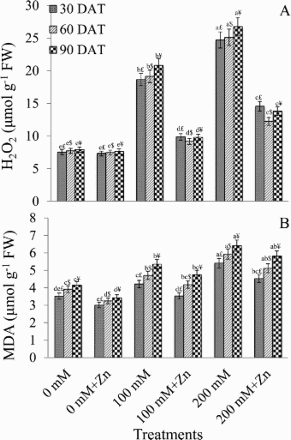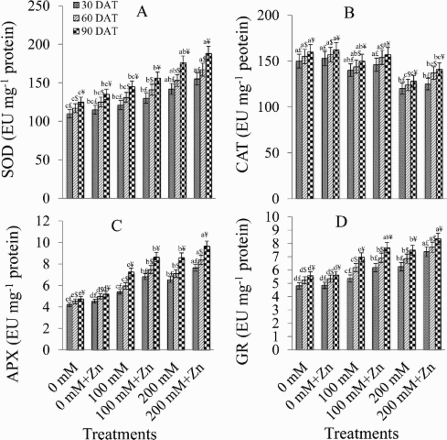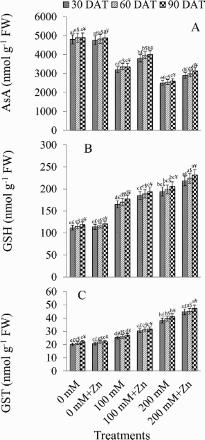Figures & data
Table 1. Effect of Zn (1 mM) on growth and biomass yield in mustard plants under NaCl stress.
Table 2. Effect of Zn (1 mM) on chlorophyll, relative water content of mustard plants under NaCl stress.
Table 3. Effect of Zn (1 mM) on electrolyte leakage and proline content of mustard plants under NaCl stress.
Figure 1. Effect of different concentrations of NaCl in the presence and absence of Zn (1 mM) on H2O2 (A) and malondialdehyde (MDA) content (B) in Brassica juncea plants. Different letters indicate significant difference (P < 0.05) among the treatments within a developmental stage. Symbols $, £ and ¥ denote significant effects of different developmental stages within a same treatment.

Figure 2. Effect of different concentrations of NaCl in the presence and absence of Zn (1 mM) on activities of superoxide dismutase (SOD) (A), catalase (CAT) (B), ascorbate peroxidase (APX) (C), and glutathione reductase (GR) (D) in Brassica juncea plants. Different letters indicate significant difference (P < 0.05) among the treatments within a developmental stage. Symbols $, £ and ¥ denote significant effects of different developmental stages within a same treatment.

Figure 3. Effect of different concentrations of NaCl in the presence and absence of Zn (1 mM) on ascorbic acid (AsA) (A), glutathione (GSH) (B) and glutathione S-transferase (GST) (C) in Brassica juncea plants. Different letters indicate significant difference (P < 0.05) among the treatments within a developmental stage. Symbols $, £ and ¥ denote significant effects of different developmental stages within a same treatment.

Figure 4. Effect of different concentrations of NaCl in presence and absence of Zn (1 mM) on total flavonoid content in Brassica juncea plants. Different letters indicate significant difference (P < 0.05) among the treatments within a developmental stage. Symbols $, £ and ¥ denote significant effects of different developmental stages within a same treatment.

